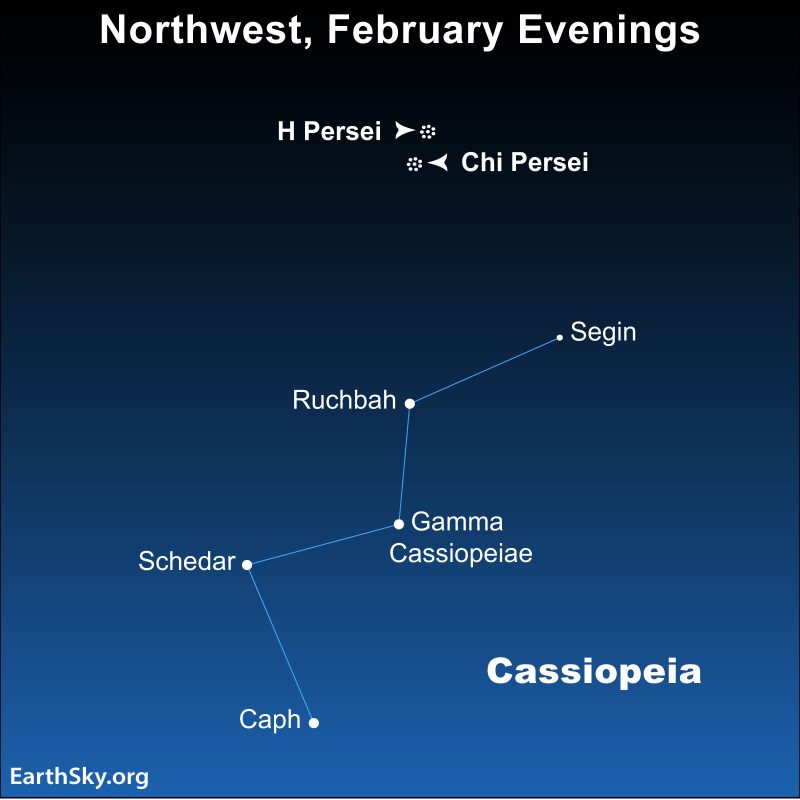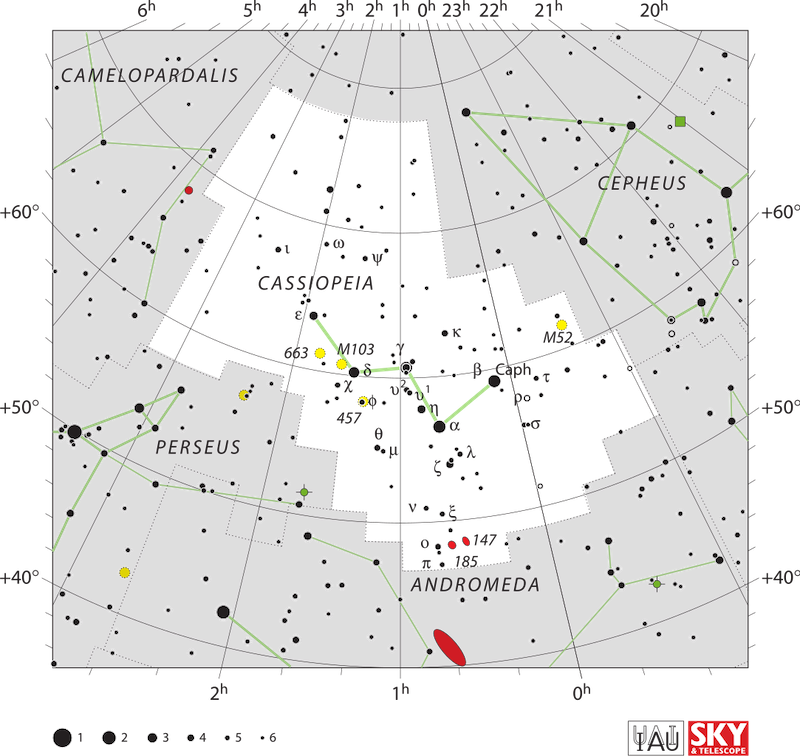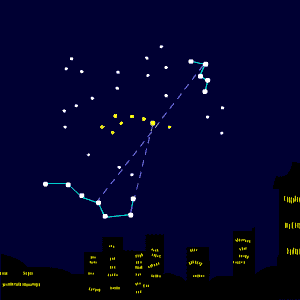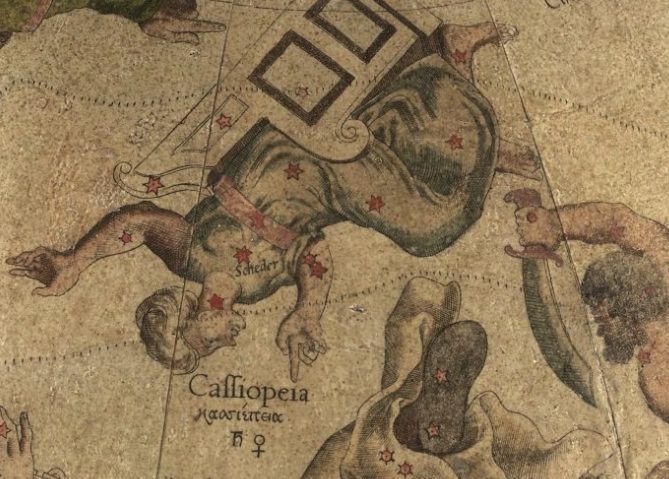
Cassiopeia the Queen in late winter and early spring
On late northern winter evenings and throughout spring, Cassiopeia the Queen descends in her throne in the northwest after nightfall. Cassiopeia is one of the easiest constellations to spot because of its distinctive shape. Cassiopeia looks like the letter W or M. Look for the Queen as your sky gets dark in February and March. She’ll be lower in the northwest as spring begins to unfold. For those in the northern U.S. and Canada, Cassiopeia is circumpolar, or above the horizon all night every night.
The stars of Cassiopeia
Cassiopeia is home to five bright stars that form the W shape. Some describe these stars as outlining the chair – or throne – she sits upon. If you’re viewing Cassiopeia as the letter W, the stars, from left to right, are Segin, Ruchbah, Gamma Cassiopeiae, Schedar and Caph.

How to find Cassiopeia
Cassiopeia is opposite the Big Dipper in the northern sky. That is, the two constellations lie on opposite sides of the pole star, Polaris. So when Cassiopeia is high in the sky, as it is on evenings from about September through February, the Big Dipper is low in the sky. Every March, when the Dipper is ascending in the northeast, getting ready to appear prominently again in the evening sky, Cassiopeia is descending in the northwest.

Neighboring star clusters
If you have a dark sky, look across the border of Cassiopeia into Perseus the Hero for a famous binocular object. It’s the Double Cluster in Perseus. They are open star clusters, each of which consists of young stars still moving together from the primordial cloud of gas and dust that gave birth to them.
In fact, these clusters have a unique set of mismatched names: H and Chi Persei. Their names are from two different alphabets, the Greek and the Roman. Stars have Greek letter names, but most star clusters don’t. Johann Bayer (1572-1625) gave Chi Persei – the cluster on the top – its Greek letter name. Then, it’s said, he ran out of Greek letters. That’s when he used a Roman letter – the letter H – to name the other cluster.

Lore of the Queen
In sky lore and in Greek mythology, Cassiopeia was a beautiful and vain queen of Ethiopia. It’s said that she committed the sin of pride by boasting that both she and her daughter Andromeda were more beautiful than Nereids, or sea nymphs.
Her boast angered Poseidon, god of the sea, who sent a sea monster (Cetus the Whale) to ravage the kingdom. To pacify the monster, Cassiopeia’s daughter, Princess Andromeda, was left tied to a rock by the sea. Cetus was about to devour her when Perseus the Hero happened by on Pegasus the Winged Horse.
Then, Perseus rescued the princess, and all lived happily … and the gods were pleased, so all of these characters were elevated to the heavens as stars.
But – because of her vanity – Cassiopeia suffered an indignity. At some times of the night or year, this constellation has more the shape of the letter M, and you might imagine the Queen reclining on her starry throne. At other times of the year or night – as in the wee hours between midnight and dawn in February and March – Cassiopeia’s Chair dips below the celestial pole. And then this constellation appears to us on Earth more like the letter W.
That’s when the Lady of the Chair – as she is sometimes called – is upside-down and said to hang on for dear life. If Cassiopeia the Queen lets go, she will drop from the sky into the ocean below, where the Nereids must still be waiting.
Bottom line: The constellation Cassiopeia the Queen has the distinct shape of a W or M. You’ll find her descending in her throne on late northern winter evenings and throughout spring nights.
Enjoying EarthSky so far? Sign up for our free daily newsletter today!
The post Cassiopeia the Queen reigns in the February sky first appeared on EarthSky.
from EarthSky https://ift.tt/aQOsKMi

Cassiopeia the Queen in late winter and early spring
On late northern winter evenings and throughout spring, Cassiopeia the Queen descends in her throne in the northwest after nightfall. Cassiopeia is one of the easiest constellations to spot because of its distinctive shape. Cassiopeia looks like the letter W or M. Look for the Queen as your sky gets dark in February and March. She’ll be lower in the northwest as spring begins to unfold. For those in the northern U.S. and Canada, Cassiopeia is circumpolar, or above the horizon all night every night.
The stars of Cassiopeia
Cassiopeia is home to five bright stars that form the W shape. Some describe these stars as outlining the chair – or throne – she sits upon. If you’re viewing Cassiopeia as the letter W, the stars, from left to right, are Segin, Ruchbah, Gamma Cassiopeiae, Schedar and Caph.

How to find Cassiopeia
Cassiopeia is opposite the Big Dipper in the northern sky. That is, the two constellations lie on opposite sides of the pole star, Polaris. So when Cassiopeia is high in the sky, as it is on evenings from about September through February, the Big Dipper is low in the sky. Every March, when the Dipper is ascending in the northeast, getting ready to appear prominently again in the evening sky, Cassiopeia is descending in the northwest.

Neighboring star clusters
If you have a dark sky, look across the border of Cassiopeia into Perseus the Hero for a famous binocular object. It’s the Double Cluster in Perseus. They are open star clusters, each of which consists of young stars still moving together from the primordial cloud of gas and dust that gave birth to them.
In fact, these clusters have a unique set of mismatched names: H and Chi Persei. Their names are from two different alphabets, the Greek and the Roman. Stars have Greek letter names, but most star clusters don’t. Johann Bayer (1572-1625) gave Chi Persei – the cluster on the top – its Greek letter name. Then, it’s said, he ran out of Greek letters. That’s when he used a Roman letter – the letter H – to name the other cluster.

Lore of the Queen
In sky lore and in Greek mythology, Cassiopeia was a beautiful and vain queen of Ethiopia. It’s said that she committed the sin of pride by boasting that both she and her daughter Andromeda were more beautiful than Nereids, or sea nymphs.
Her boast angered Poseidon, god of the sea, who sent a sea monster (Cetus the Whale) to ravage the kingdom. To pacify the monster, Cassiopeia’s daughter, Princess Andromeda, was left tied to a rock by the sea. Cetus was about to devour her when Perseus the Hero happened by on Pegasus the Winged Horse.
Then, Perseus rescued the princess, and all lived happily … and the gods were pleased, so all of these characters were elevated to the heavens as stars.
But – because of her vanity – Cassiopeia suffered an indignity. At some times of the night or year, this constellation has more the shape of the letter M, and you might imagine the Queen reclining on her starry throne. At other times of the year or night – as in the wee hours between midnight and dawn in February and March – Cassiopeia’s Chair dips below the celestial pole. And then this constellation appears to us on Earth more like the letter W.
That’s when the Lady of the Chair – as she is sometimes called – is upside-down and said to hang on for dear life. If Cassiopeia the Queen lets go, she will drop from the sky into the ocean below, where the Nereids must still be waiting.
Bottom line: The constellation Cassiopeia the Queen has the distinct shape of a W or M. You’ll find her descending in her throne on late northern winter evenings and throughout spring nights.
Enjoying EarthSky so far? Sign up for our free daily newsletter today!
The post Cassiopeia the Queen reigns in the February sky first appeared on EarthSky.
from EarthSky https://ift.tt/aQOsKMi

Aucun commentaire:
Enregistrer un commentaire